2018/11/6
Inside Waymo's Secret World for Training Self-Driving Cars - The Atlantic
Inside Waymo's Secret World for Training Self-Driving
Cars
,
,
N A CORNER of Alphabet’s campus, there is a team working on a piece of
software that may be the key to self-driving cars. No journalist has ever seen
it in action until now. They call it Carcraft, after the popular game World of
Warcraft.
The software’s creator, a shaggy-haired, baby-faced young engineer named
James Stout, is sitting next to me in the headphones-on quiet of the open-plan
https://www.theatlantic.com/technology/archive/2017/08/inside-waymos-secret-testing-and-simulation-facilities/537648/
1/24
�
�
2018/11/6
Inside Waymo's Secret World for Training Self-Driving Cars - The Atlantic
office. On the screen is a virtual representation of a roundabout. To human eyes,
it is not much to look at: a simple line drawing rendered onto a road-textured
background. We see a self-driving Chrysler Pacifica at medium resolution and a
simple wireframe box indicating the presence of another vehicle.
,
’
(
)
Months ago, a self-driving car team encountered a roundabout like this in Texas.
The speed and complexity of the situation flummoxed the car, so they decided to
build a look-alike strip of physical pavement at a test facility. And what I’m
looking at is the third step in the learning process: the digitization of the real-
world driving. Here, a single real-world driving maneuver—like one car cutting
off the other on a roundabout—can be amplified into thousands of simulated
scenarios that probe the edges of the car’s capabilities.
Listen to the audio version of this article:
TheAtlantic
TheAtlantic
Inside Waymo's Secret World for Trainin……
Inside Waymo's Secret World for Trainin
Feature stories, read aloud: download the Audm app for your iPhone.
Scenarios like this form the base for the company’s powerful simulation
apparatus. “The vast majority of work done—new feature work—is motivated by
4K
https://www.theatlantic.com/technology/archive/2017/08/inside-waymos-secret-testing-and-simulation-facilities/537648/
2/24
�
2018/11/6
Inside Waymo's Secret World for Training Self-Driving Cars - The Atlantic
stuff seen in simulation,” Stout tells me. This is the tool that’s accelerated the
development of autonomous vehicles at Waymo, which Alphabet (née Google)
spun out of its “moon-shot” research wing, X, in December of 2016.
If Waymo can deliver fully autonomous vehicles in the next few years, Carcraft
should be remembered as a virtual world that had an outsized role in reshaping
the actual world on which it is based.
Originally developed as a way to “play back” scenes that the cars experienced
while driving on public roads, Carcraft, and simulation generally, have taken on
an ever-larger role within the self-driving program.
At any time, there are now 25,000 virtual self-driving cars making their way
through fully modeled versions of Austin, Mountain View, and Phoenix, as well
as test-track scenarios. Waymo might simulate driving down a particularly tricky
road hundreds of thousands of times in a single day. Collectively, they now drive
8 million miles per day in the virtual world. In 2016, they logged 2.5 billion
virtual miles versus a little over 3 million miles by Google’s IRL self-driving cars
that run on public roads. And crucially, the virtual miles focus on what Waymo
people invariably call “interesting” miles in which they might learn something
new. These are not boring highway commuter miles.
The simulations are part of an intricate process that Waymo has developed.
They’ve tightly interwoven the millions of miles their cars have traveled on
public roads with a “structured testing” program they conduct at a secret base in
the Central Valley they call Castle.
Waymo has never unveiled this system before. The miles they drive on regular
roads show them areas where they need extra practice. They carve the spaces
they need into the earth at Castle, which lets them run thousands of different
scenarios in situ. And in both kinds of real-world testing, their cars capture
enough data to create full digital recreations at any point in the future. In that
virtual space, they can unhitch from the limits of real life and create thousands of
variations of any single scenario, and then run a digital car through all of them.
As the driving software improves, it’s downloaded back into the physical cars,
which can drive more and harder miles, and the loop begins again.
https://www.theatlantic.com/technology/archive/2017/08/inside-waymos-secret-testing-and-simulation-facilities/537648/
3/24
�
2018/11/6
Inside Waymo's Secret World for Training Self-Driving Cars - The Atlantic
O GET TO Castle, you drive east from San Francisco Bay and south on 99,
the Central Valley highway that runs south to Fresno. Cornfields abut
subdevelopments; the horizon disappears behind agricultural haze. It’s
30 degrees hotter than San Francisco and so flat that the grade of this “earthen
sea,” as John McPhee called it, can only be measured with lasers. You exit near
the small town of Atwater, once the home of the Castle Air Force Base, which
used to employ 6,000 people to service the B-52 program. Now, it’s on the
northern edge of the small Merced metro area, where unemployment broke 20
percent in the early 2010s, and still rarely dips below 10 percent. Forty percent
of the people around here speak Spanish. We cross some railroad tracks and
swing onto the 1,621 acres of the old base, which now hosts everything from
Merced County Animal Control to the U.S. Penitentiary, Atwater.
The directions in my phone are not pointed to an address, but a set of GPS
coordinates. We proceed along a tall opaque green fence until Google Maps tells
us to stop. There’s nothing to indicate that there’s even a gate. It just looks like
another section of fence, but my Waymo host is confident. And sure enough: A
security guard appears and slips out a widening crack in the fence to check our
credentials.
https://www.theatlantic.com/technology/archive/2017/08/inside-waymos-secret-testing-and-simulation-facilities/537648/
4/24
�
2018/11/6
Inside Waymo's Secret World for Training Self-Driving Cars - The Atlantic
(
)
The fence parts and we drive into a bustling little campus. Young people in shorts
and hats walk to and fro. There are portable buildings, domed garages, and—in
the parking lot of the main building—self-driving cars. This is a place where there
are several types of autonomous vehicle: the Lexus models that you’re most likely
to see on public roads, the Priuses that they’ve retired, and the new Chrysler
Pacifica minivans.
The self-driving cars are easy to pick out. They’re studded with sensors. The
most prominent are the laser scanners (usually called LIDARs) on the tops of the
cars. But the Pacificas also have smaller beer-can-sized LIDARs spinning near
their side mirrors. And they have radars at the back which look disturbingly like
white Shrek ears.
When a car’s sensors are engaged, even while parked, the spinning LIDARs
make an odd sound. It’s somewhere between a whine and a whomp, unpleasant
only because it’s so novel that my ears can’t filter it out like the rest of the car
noises that I’ve grown up with.
https://www.theatlantic.com/technology/archive/2017/08/inside-waymos-secret-testing-and-simulation-facilities/537648/
5/24
�
2018/11/6
Inside Waymo's Secret World for Training Self-Driving Cars - The Atlantic
There is one even more special car parked across the street from the main
building. All over it, there are X’s of different sizes applied in red duct tape.
That’s the Level Four car. The levels are Society of Automotive Engineers
designations for the amount of autonomy that the car has. Most of what we hear
about on the roads is Level One or Level Two, meant to allow for smart cruise
control on highways. But the red-X car is a whole other animal. Not only is it fully
autonomous, but it cannot be driven by the humans inside it, so they don’t want
to get it mixed up with their other cars.
As we pull into the parking lot, there are whiffs of Manhattan Project, of scientific
outpost, of tech startup. Inside the main building, a classroom-sized portable, I
meet the motive force behind this remarkable place. Her name is Steph Villegas.
ILLEGAS WEARS a long, fitted white collared shirt, artfully torn jeans, and
gray knit sneakers, every bit as fashionable as her pre-Google job at
the San Francisco boutique Azalea might suggest. She grew up in the
East Bay suburbs on the other side of the hills from Berkeley and was a fine-arts
major at University of California, Berkeley before finding her way into the self-
driving car program in 2011.
“You were a driver?” I ask.
“Always a driver,” Villegas says.
“Being in the car a lot, I can feel what the car is doing—it
sounds weird, but—with my butt.”
She spent countless hours going up and down 101 and 280, the highways that
lead between San Francisco and Mountain View. Like the rest of the drivers, she
came to develop a feel for how the cars performed on the open road. And this
came to be seen as an important kind of knowledge within the self-driving
program. They developed an intuition about what might be hard for the cars.
“Doing some testing on newer software and having a bit of tenure on the team, I
began to think about ways that we could potentially challenge the system,” she
tells me.
https://www.theatlantic.com/technology/archive/2017/08/inside-waymos-secret-testing-and-simulation-facilities/537648/
6/24
�
2018/11/6
Inside Waymo's Secret World for Training Self-Driving Cars - The Atlantic
So, Villegas and some engineers began to cook up and stage rare scenarios that
might allow them to test new behaviors in a controlled way. They started to
commandeer the parking lot across from Shoreline Amphitheater, stationing
people at all the entrances to make sure only approved Googlers were there.
“That’s where it started,” she says. “It was me and a few drivers every week.
We’d come up with a group of things that we wanted to test, get our supplies in a
truck, and drive the truck down to the lot and run the tests.”
These became the first structured tests in the self-driving program. It turns out
that the hard part is not really the what-if-a-zombie-is-eating-a-person-in-the-
road scenarios people dream up, but proceeding confidently and reliably like a
human driver within the endless variation of normal traffic.
Villegas started gathering props from wherever she could find them: dummies,
cones, fake plants, kids’ toys, skateboards, tricycles, dolls, balls, doodads. All of
them went into the prop stash. (Eventually, the props were stored in a tent, and
now at Castle, in a whole storage unit.)
(
)
https://www.theatlantic.com/technology/archive/2017/08/inside-waymos-secret-testing-and-simulation-facilities/537648/
7/24
�
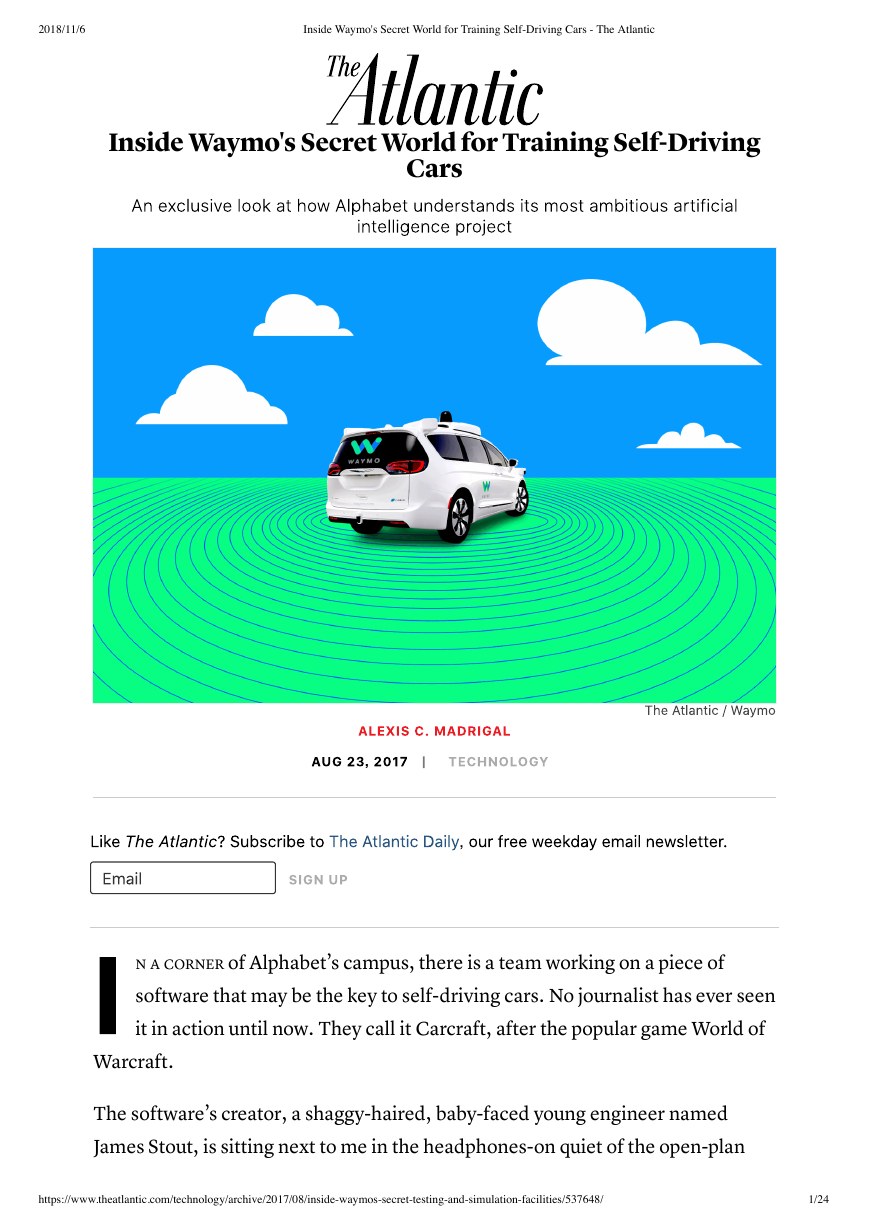
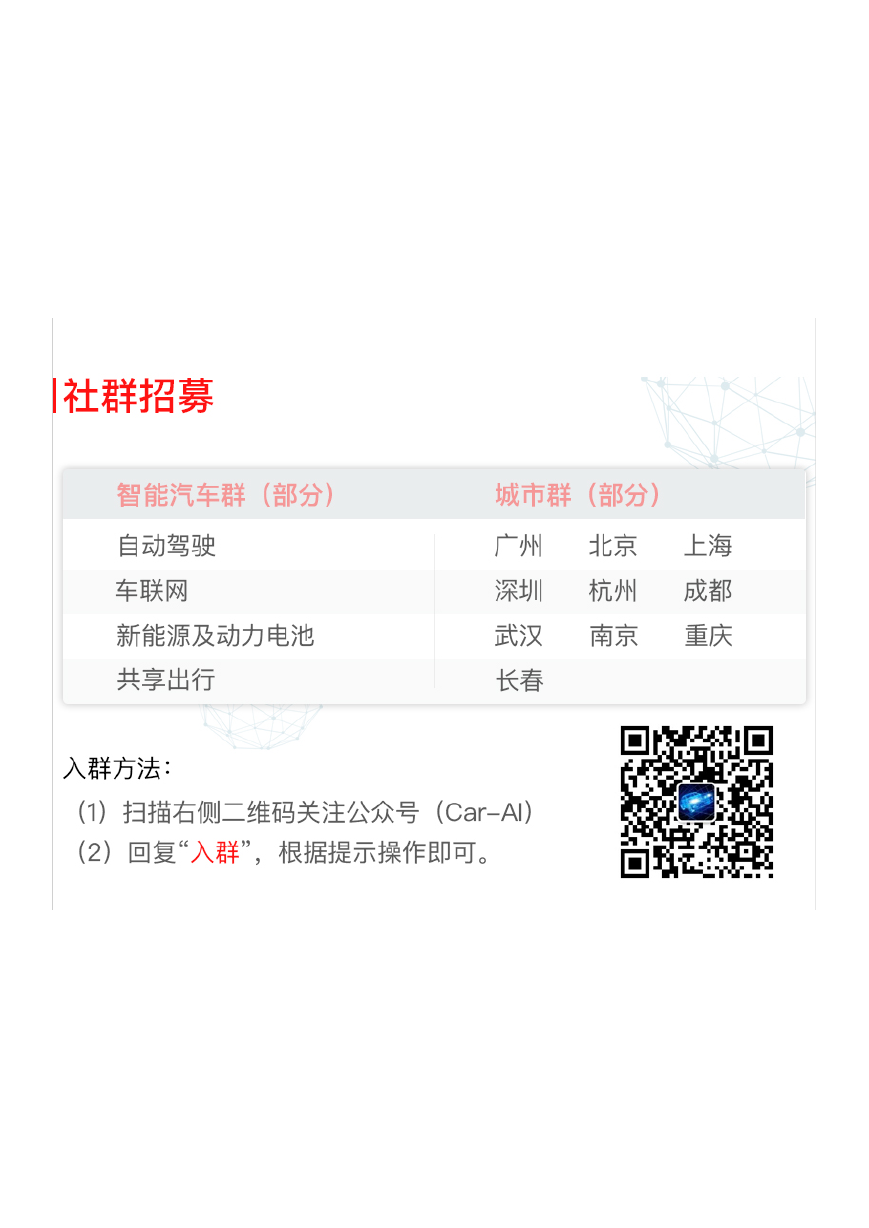

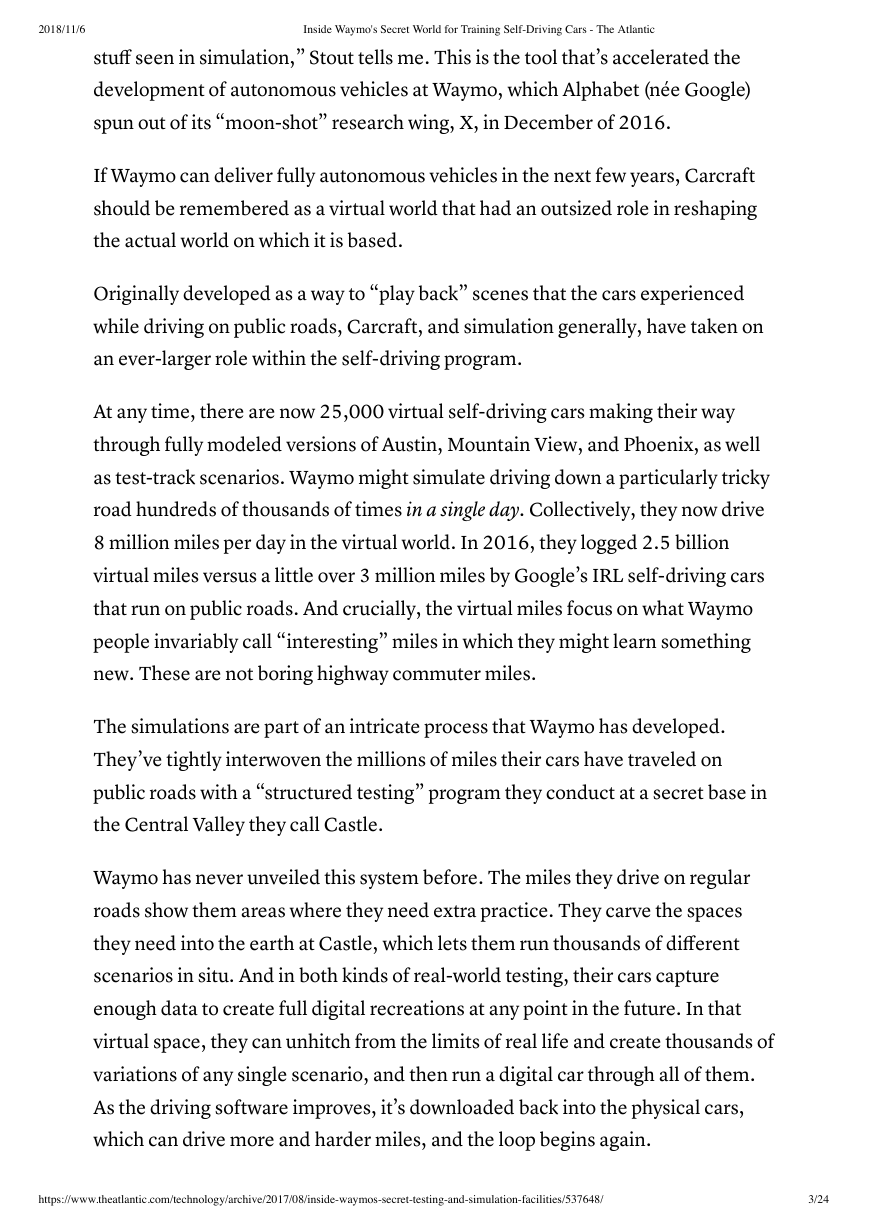

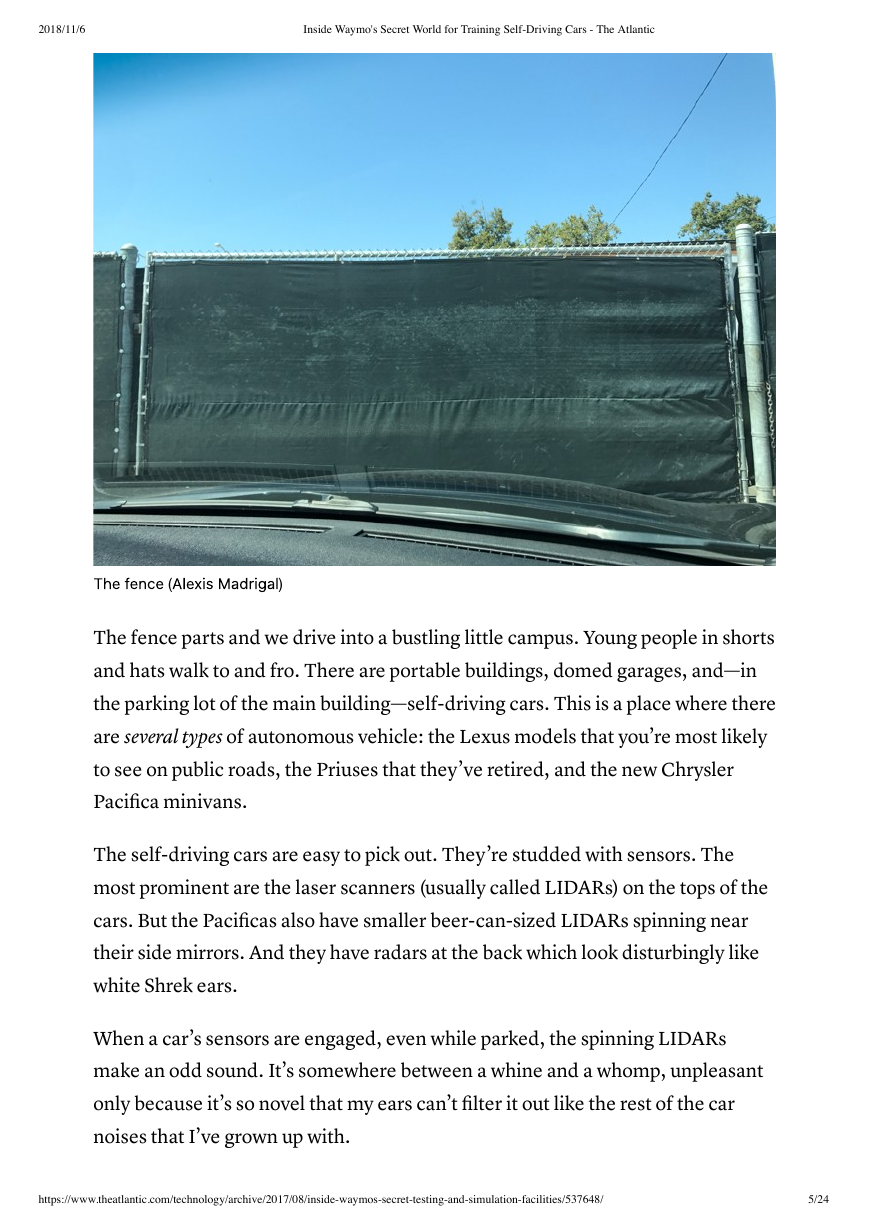
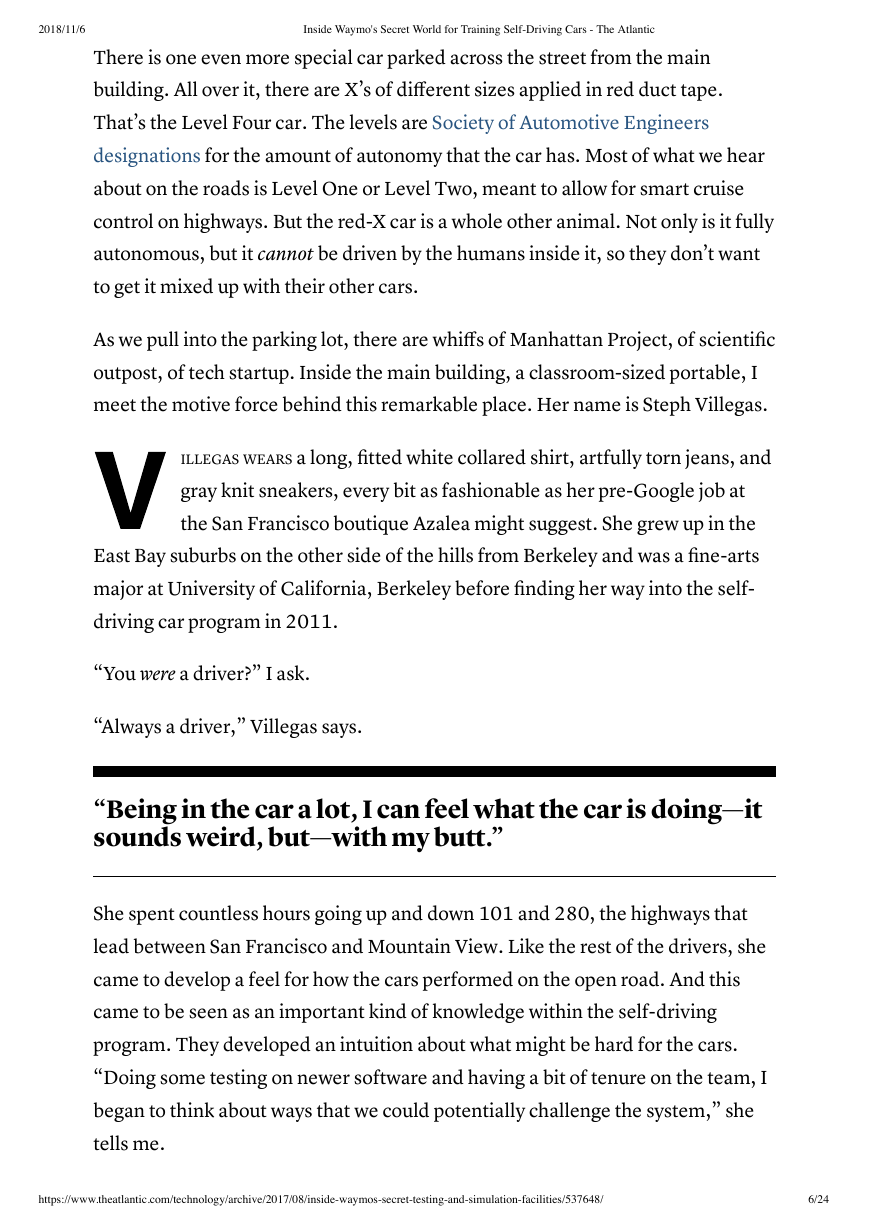
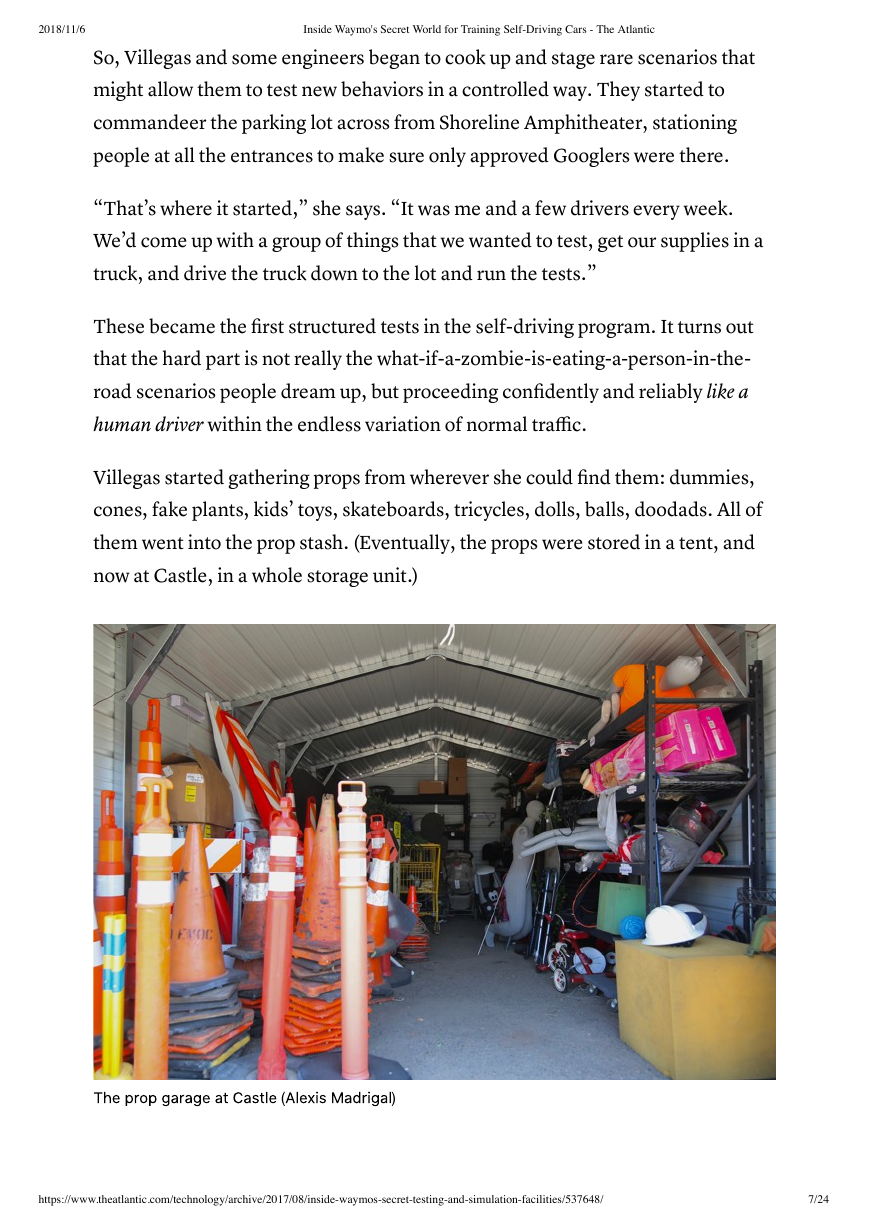








 2023年江西萍乡中考道德与法治真题及答案.doc
2023年江西萍乡中考道德与法治真题及答案.doc 2012年重庆南川中考生物真题及答案.doc
2012年重庆南川中考生物真题及答案.doc 2013年江西师范大学地理学综合及文艺理论基础考研真题.doc
2013年江西师范大学地理学综合及文艺理论基础考研真题.doc 2020年四川甘孜小升初语文真题及答案I卷.doc
2020年四川甘孜小升初语文真题及答案I卷.doc 2020年注册岩土工程师专业基础考试真题及答案.doc
2020年注册岩土工程师专业基础考试真题及答案.doc 2023-2024学年福建省厦门市九年级上学期数学月考试题及答案.doc
2023-2024学年福建省厦门市九年级上学期数学月考试题及答案.doc 2021-2022学年辽宁省沈阳市大东区九年级上学期语文期末试题及答案.doc
2021-2022学年辽宁省沈阳市大东区九年级上学期语文期末试题及答案.doc 2022-2023学年北京东城区初三第一学期物理期末试卷及答案.doc
2022-2023学年北京东城区初三第一学期物理期末试卷及答案.doc 2018上半年江西教师资格初中地理学科知识与教学能力真题及答案.doc
2018上半年江西教师资格初中地理学科知识与教学能力真题及答案.doc 2012年河北国家公务员申论考试真题及答案-省级.doc
2012年河北国家公务员申论考试真题及答案-省级.doc 2020-2021学年江苏省扬州市江都区邵樊片九年级上学期数学第一次质量检测试题及答案.doc
2020-2021学年江苏省扬州市江都区邵樊片九年级上学期数学第一次质量检测试题及答案.doc 2022下半年黑龙江教师资格证中学综合素质真题及答案.doc
2022下半年黑龙江教师资格证中学综合素质真题及答案.doc